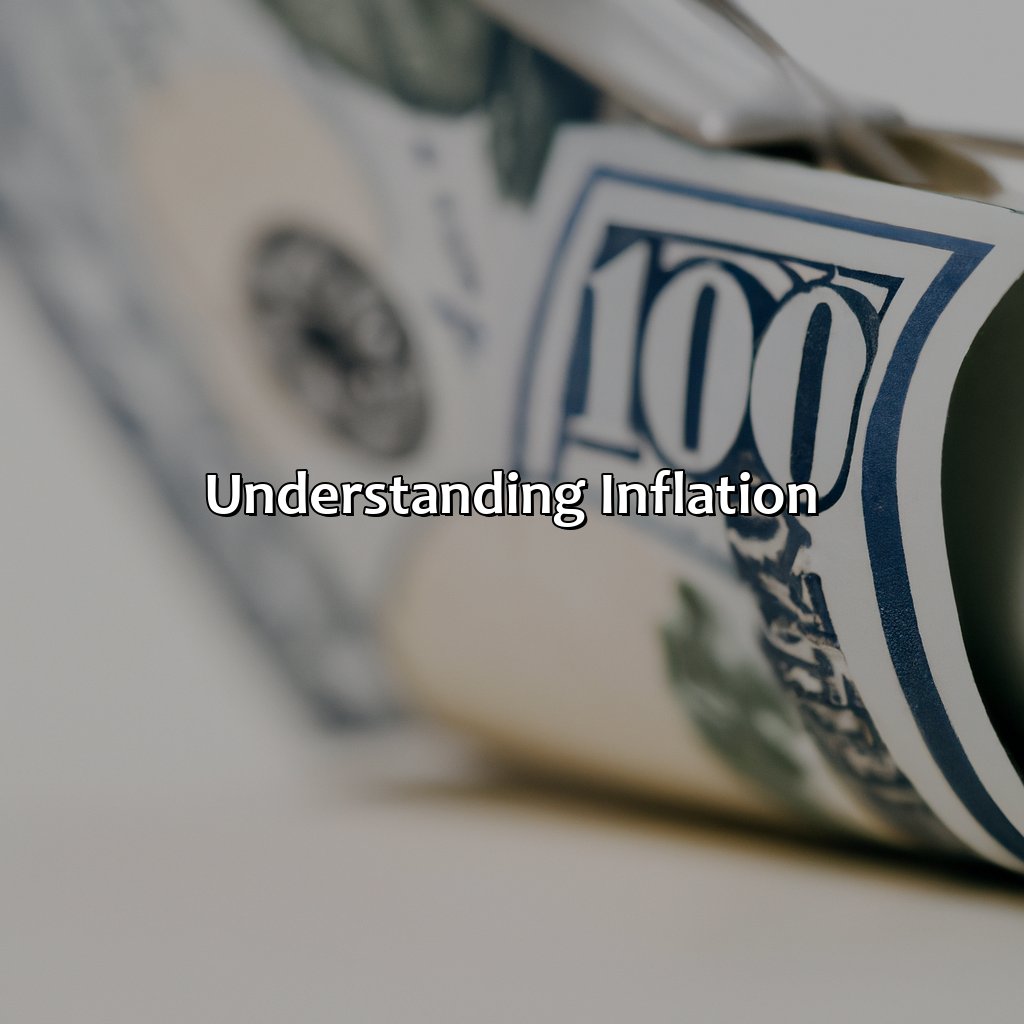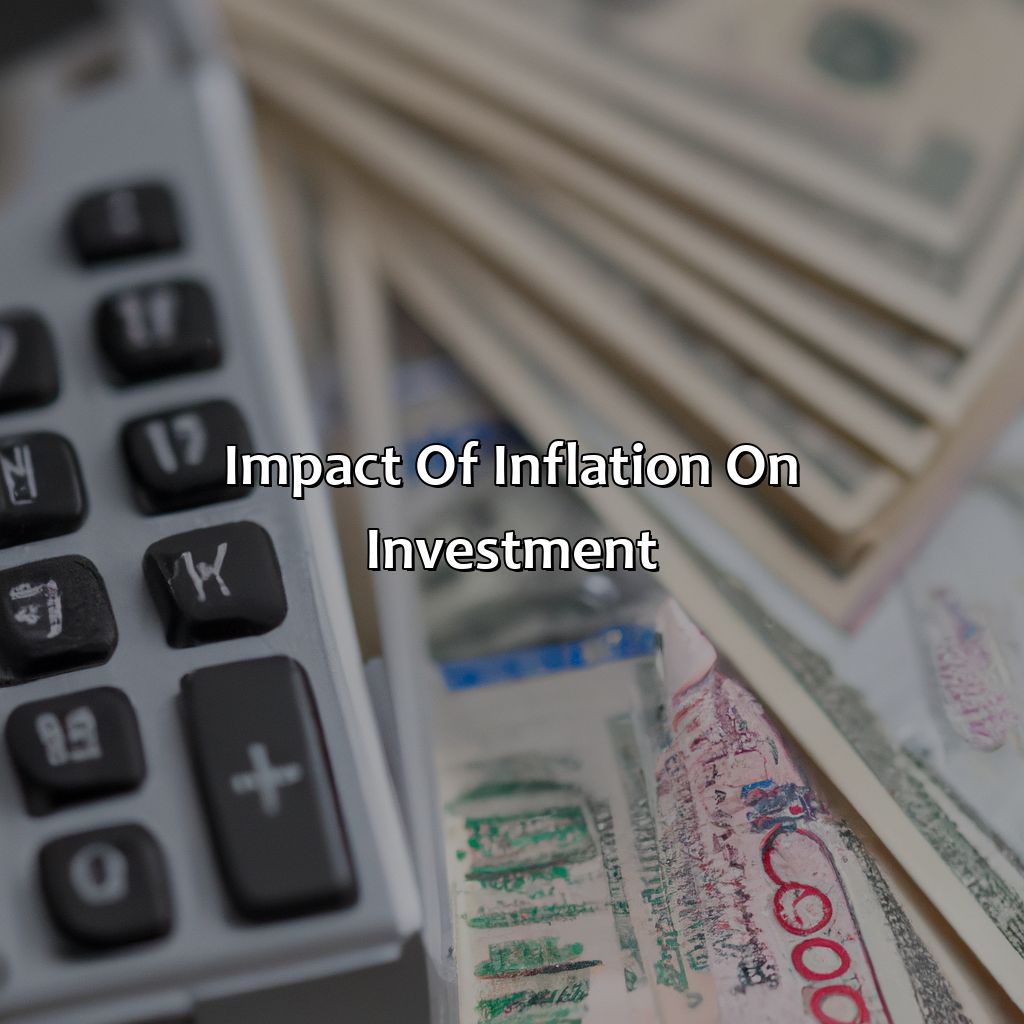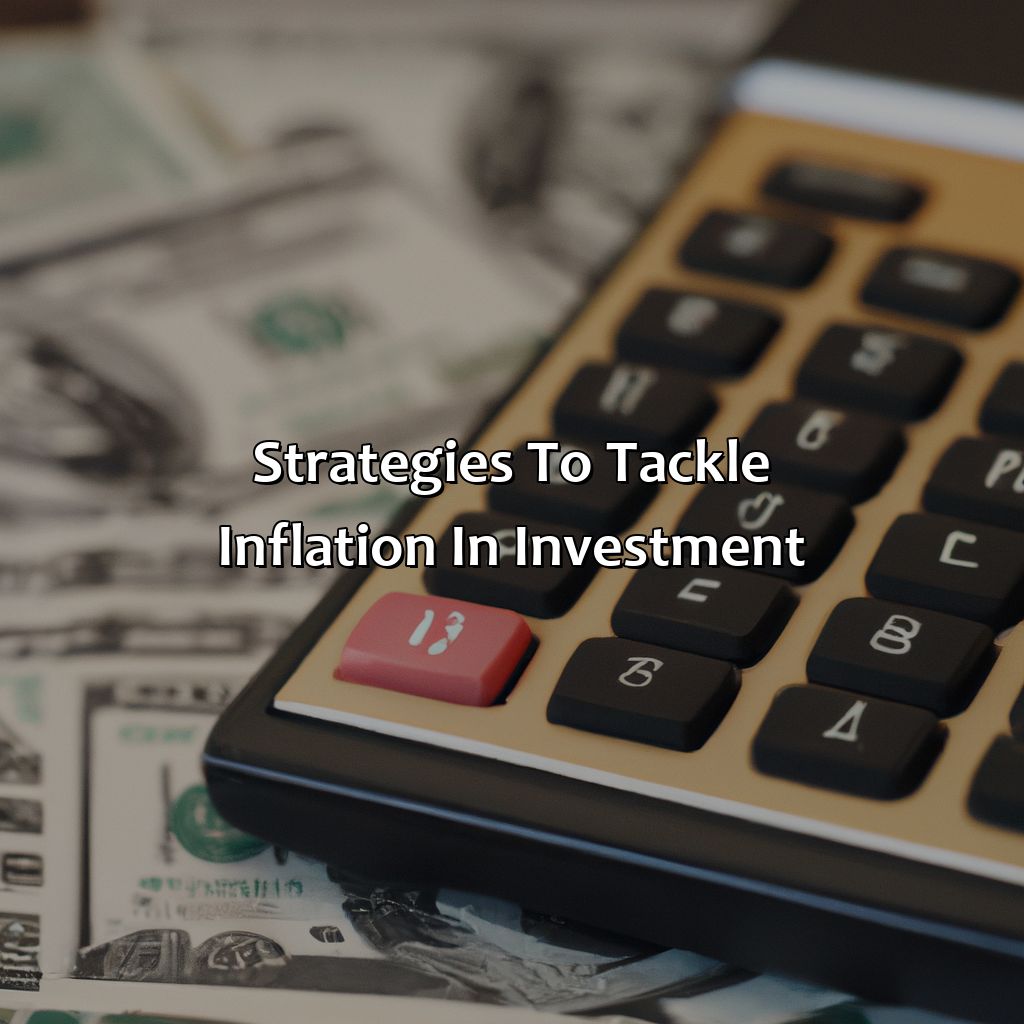How Inflation Affects Investment?
Key Takeaway:
- Inflation reduces the purchasing power of money, which means that the same amount of money can buy fewer goods and services over time. This can have a significant impact on investment returns and should be factored into investment decisions.
- Real returns on investment can be reduced due to the effects of inflation. This means that even if an investment appears to be performing well, the actual value of the investment may be eroded by inflation. It is important to consider inflation when evaluating investment returns.
- Investing in inflation-protected securities, diversifying a portfolio, and investing in commodities are all strategies that can help investors tackle the impact of inflation on their investments. By taking these steps, investors can protect their wealth from the negative effects of inflation and achieve their long-term financial goals.
Are you worried about how inflation may impact your investments? Learn more on how you can stay ahead of inflation and make wise investment decisions with this comprehensive guide.
Understanding Inflation
To get the hang of inflation, we must recognize its meaning and causes. So, we’ve split this section “Understanding Inflation” into two parts:
- Meaning of Inflation
- Causes of Inflation
These divisions will give us a quick understanding of what inflation is and what factors bring it about.

Image credits: retiregenz.com by David Arnold
Meaning of Inflation
Inflation is a monetary phenomenon that causes the rise in the general price level of goods and services in an economy. It erodes the purchasing power of a currency over time, reducing the value of savings and income. As inflation increases, the cost of borrowing tends to increase too, making it more expensive for businesses and individuals to invest.
Investors need to be aware of how inflation affects their investments since high inflation can lead to lower returns and greater risks. One way to protect against inflation is to invest in assets that have historically performed well during times of inflation, such as commodities or real estate.
It is crucial to monitor the inflation rate regularly as it can affect investment decisions. Rising inflation may prompt investors to adjust their portfolios by investing in stocks or other assets that tend to outperform during high inflation conditions.
Experts suggest a diversified portfolio with investments across multiple asset classes, including equities, bonds, commodities, and real estate. A well-diversified portfolio can help reduce risk while generating better returns.
When infamous Zimbabwean hyperinflation hit its peak around 2008-2009, its citizens had to carry bags full of banknotes just to buy basic groceries like bread or milk. This situation highlights how devastating hyperinflation can be for citizens and investors alike if they do not take measures to protect themselves against it.
Inflation is like a horror movie plot twist – just when you think it’s over, it comes back even stronger.
Causes of Inflation
The factors that lead to a rise in the overall price level, which is commonly known as inflation, are multifarious and complex. The concept of inflation is closely tied to the monetary policy and macroeconomic factors that affect money supply, demand, and velocity.
The primary driver of inflation is an increase in demand for goods and services not met by an equivalent increase in supply or production capacity. This can occur due to various reasons such as rapid economic growth, population growth, or changes in consumer preferences. Another cause of inflation may be attributed to the cost-push effect where there is a rise in production costs from wages or raw materials that ultimately reduce profit margins leading to higher prices.
Apart from these causes, there are other reasons like monetary expansion, excessive government spending, changes in exchange rates, natural disasters or external shocks that impact pricing decisions.
It’s essential to track inflation trends as they have significant implications on investments such as bonds, stocks, real estate etc. High inflation hurts returns on fixed-income investments by eroding the purchasing power of interest income over time. Investing in equities might however provide better returns during instances of high inflation.
Historically speaking; hyperinflations like those seen during Weimar Republic (1921-23) or Zimbabwe (1998 – 2009) have had devastating impacts on both investment portfolios and entire economies. Regardless of these extremes at any level, understanding inflation will help you manage your money efficiently during periods when inflationary pressures are present.
Inflation can make your investments feel like they’re on a rollercoaster – except instead of excitement, you’re feeling car sickness.
Impact of Inflation on Investment
To understand the effects of inflation on investments, get into its details. Money’s buying power getting less, real returns shrinking, and investment risk growing are all factors that can create economic instability. Don’t worry though! By finding out more about these three things – purchasing power, real returns, and risk– you can make sound investment decisions.

Image credits: retiregenz.com by James Arnold
Decrease in Purchasing Power of Money
The decline in the monetary value of an investment, caused by rising prices of goods and services is known as the effect of inflation on purchasing power. This drop in purchasing power is measured by comparing the amount paid for goods today to what that same amount would have purchased years ago. This phenomenon has a pronounced impact on investments affecting its rate of return.
Inflationary conditions lead to a decrease in the real value of principal and mutual profits. The interest payments from fixed-income investments like bonds tend to reduce whereas rental values on property become insignificant in times of high inflation rates; reducing revenues generated by these investments. The result means investors experience negative real returns on their investments since the underlying assets’ value is mostly eroded by inflation.
Understanding how inflation affects various types of investments, its capacity to disrupt and diminish returns, becomes crucial to investors who quest for wealth preservation through growth and security. It necessitates investment strategies that consider taking into account those alternative investment choices whose potential earnings surpass current inflation rates.
According to Investopedia, it has been observed that between 1900-2021, consumer prices rose 2,470%. Inflation averaging about 3% per year leads to prices doubling over a 24-year period illustrating the need for Investors to allocate their resources differently under varying inflation scenarios.
Saving money is like playing a game of Whack-a-Mole during inflation – just when you think you’ve got a good return on investment, inflation pops up and knocks it back down.
Reduction in Real Returns
The impact of inflation on investments can result in a decrease in actual gains, known as ‘reduction in real returns’. This occurs when the nominal return earned on an investment is less than the rate of inflation. Therefore, although the investor may make a profit in terms of percentages or numbers, their purchasing power decreases due to inflation.
Investors can reduce the negative effect of inflation by choosing investments that offer higher rates of return than the current inflation rate. It’s crucial to remember that high-return investments may come with higher risks and require more significant capital investment.
It’s also essential for investors to consider long-term financial goals while taking inflation into account when making investment decisions. Sophisticated investors often account for inflation in their investment strategies to ensure they maximize investment outcomes without any unforeseen surprises.
Pro tip: One way to mitigate the risk associated with inflationary pressures is through diversification into various asset classes such as commodities, equities, real estate and bonds.
Investing is a bit like playing Russian roulette, you just hope that the bullet of inflation doesn’t hit you.
Risk of Investment
Investment exposes to various negative possibilities. Investors are always exposed to various negative possibilities while investing their money. The risk of investment is the potentiality of losing capital or not achieving the desired returns due to market fluctuations, political change, economic crisis, and other uncertainties. This risk varies depending on investors’ ability to tolerate volatility in asset prices and their individual preferences for financial goals.
Inflation plays a vital role in investment risk. Investment risk is also affected by inflation rates. The impact of inflation on an investment can be positive or negative. Inflation causes the value of money to decrease over time, which erodes the rate of return from investments. Investors must keep track of inflation rates and adjust their portfolios accordingly, taking proper measures to avoid any unwanted consequences.
The need for diversification for lowering investment risk. To mitigate investment risk arising from inflation or other uncertain changes in the market, investors should have diversified portfolios comprising different asset classes such as stocks, bonds, and commodities that offer an excellent chance for income growth at different times. Additionally, portfolio diversification may include investing in foreign equities as well as alternative investments like hedge funds, real estate assets, etc.
Pro Tip: Creating a well-diversified portfolio with diverse assets is the most effective approach to mitigating investment risks associated with possible inflationary pressures or other uncertainties facing markets around the world. Investing wisely in the face of inflation is like playing poker with a deck of cards that keep changing every few seconds.
Strategies to Tackle Inflation in Investment
Tackling inflation while investing? Strategies can help! Invest in inflation-protected securities that benefit from inflation, not lose their value. Diversify your portfolio to manage the risk of investing during an inflationary period. Also, invest in commodities for a hedge against inflation. This can balance the portfolio overall.

Image credits: retiregenz.com by Joel Woodhock
Investing in Inflation-Protected Securities
To protect investments from inflation, investing in securities that provide inflation protection is crucial. These securities are designed to increase or decrease with changes in the consumer price index, thus providing a hedge against inflation. Investing in these securities can be done through bonds and mutual funds, which can be bought through brokers or on online platforms.
Investing in inflation-protected securities can be an effective way of tackling the negative effects of inflation on investments. These securities offer a guaranteed return rate adjusted for inflation and are an attractive option for investors looking for long-term growth. Not only do they help to preserve the value of your money, but also provide a steady income stream during periods of economic uncertainty.
One unique aspect of investing in these securities is that they do not carry any credit risk since they are issued by the government or other large institutions. This eliminates the possibility of default risk—something that traditional fixed-income investments are exposed to.
Investors should also consider diversifying their portfolio with other types of assets such as real estate or precious metals as this provides an additional layer of protection against unpredictable market conditions.
In summary, investing in inflation-protected securities can be an effective tool for investors concerned about the negative impact of rising prices on their investment portfolios. By providing a guaranteed return rate adjusted for inflation and eliminating default risk, these securities offer a safe haven during periods of economic uncertainty. Moreover, diversification into other asset classes is crucial to mitigate risks in investment portfolios.
Putting all your investment eggs in one basket is like playing a game of Jenga with your financial future.
Diversification of Portfolio
The art of investing demands an approach that is dynamic and flexible. To counter inflation’s adverse effects, it is crucial to have a portfolio that is diversified in nature. Diversification of Investment Portfolio can be viewed as a smart strategy to spread risks and achieve long-term financial goals.
Diversification moves beyond just having multiple investment vehicles; it provides the opportunity to allocate funds into different asset classes like equities, fixed income securities, commodities, real estate, etc. By doing so, one reduces the risk associated with relying on a single security or asset class since various investments will perform differently under varying economic scenarios.
To maximize returns within a diversified portfolio, Investors can use other Investment Strategies such as Averaging Down or Up. Averaging down involves buying more units of an asset whose value declines but has excellent long-term prospects with hopes it will recover shortly. In contrast, averaging up involves gradually increasing an investor’s allocation in assets that have sustained high performance over time.
Investors must also keep track of their portfolio regularly by regularly monitoring their diversification plan and rejigging positions if necessary. This way they mitigate any potential risks and ensure they are on top of any new developments or shifts in market trends.
Want to hedge against inflation? Invest in commodities, because unlike money, the value of a can of beans doesn’t deflate.
Investing in Commodities
Investing in tangible assets like physical commodities can be a wise choice as it allows for portfolio diversification and acts as a hedge against inflation. The value of commodities is determined by the basic forces of supply and demand making them an attractive investment option.
Additionally, commodities can be categorized into hard or soft commodities depending on their physical characteristics which further diversifies the investment portfolio. For instance, investing in metals like gold and silver can be seen as a safe-haven investment whereas investing in agricultural commodities like corn or wheat can provide liquidity due to their short-term contracts.
Moreover, investing in commodities through futures contracts can provide higher returns than spot trading, but it comes with its own set of risks. A well thought out investment strategy must be formulated before venturing into this type of investment avenue. Investing in a commodity index or exchange-traded funds (ETFs) can also provide exposure to multiple commodity types without having to manage individual contracts.
To make the most out of investing in commodities, it is essential to keep track of market trends, maintain a diversified asset allocation, and avoid market timing. Commodity investments tend to perform better during periods of high inflation making it an excellent go-to option when inflation is on the rise. However, careful analysis is necessary before including this form of investment in your portfolio as trading in commodity markets carries an inherent risk that you should be willing to take.
Five Well-Known Facts About How Inflation Affects Investment:
Inflation erodes the purchasing power of money, reducing the real rate of return on investments. (Source: Investopedia)
Inflation can lead to increased uncertainty in financial markets, making it more difficult to predict returns on investments. (Source: The Balance)
Stocks and other equity investments can be a good hedge against inflation, as they have the potential for higher returns than fixed-income investments. (Source: US News)
Real estate investments can also be a good hedge against inflation, as rising property values can help to offset the effect of inflation. (Source: Forbes)
Investors can use inflation-indexed securities, such as TIPS, to protect their investments against inflation. (Source: The Balance)
FAQs about How Inflation Affects Investment?
1. How does inflation affect investment?
Inflation can have a significant impact on your investments. When inflation rates rise, the cost of goods and services increase, which can lower purchasing power. This means that the return on your investment may not keep up with inflation, resulting in a decreased value of your investment over time.
2. What type of investments are more vulnerable to inflation?
Investments that are more vulnerable to inflation include cash, bonds with fixed interest rates, and other low-risk investments. These types of investments offer low returns that may not keep up with inflation.
3. Are there any investments that can beat inflation?
Yes, some investments can beat inflation, such as stocks, real estate, and commodities. These investments have the potential to increase in value over time, even as inflation rates rise.
4. Should I change my investment strategy due to inflation?
It may be a good idea to adjust your investment strategy in response to inflation. Consider investing in assets that are more likely to increase in value, such as stocks or real estate. Additionally, adding inflation-protected securities to your portfolio can help protect against inflation.
5. How can I protect my investments from inflation?
One way to protect your investments from inflation is to diversify your portfolio. This means investing in a variety of assets, such as stocks, bonds, real estate, and commodities. Additionally, investing in inflation-protected securities can help to counteract the effects of inflation.
6. What is the role of interest rates in inflation and investment?
Interest rates can have a significant impact on both inflation and investment. When interest rates rise, borrowing becomes more expensive, which can slow down economic growth and decrease inflation. Additionally, rising interest rates can make certain investments, such as bonds, less attractive. On the other hand, falling interest rates can stimulate economic growth and increase inflation, which can make stocks and other assets more attractive.
 Checkout this IRS Loophole
Checkout this IRS Loophole 
